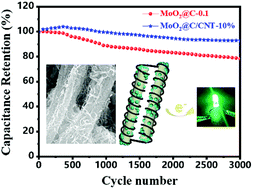Enhanced pseudocapacitive energy storage properties of budding-branch like MoO2@C/CNT nanorods†
Abstract
Despite its high theoretical capacitance, molybdenum dioxide still cannot be well applied in supercapacitors due to its low conductivity and structural instability. Generally, compositing molybdenum dioxides with carbon materials can provide new possibilities. In this work, we successfully fabricated a budding-branch like MoO2@C composite wrapped by carbon nanotubes (CNTs). Different from those MoO2 nanodots synthesized by traditional approaches, the MoO2 nanodots in this composite were distributed uniformly inside the carbon rods, which effectively alleviated their self-aggregation and benefited their electron transportation. The introduction of the CNTs further provided the composite with better contact with the electrolyte and increased charge transfer. The prepared MoO2@C/CNT electrode exhibits a superior specific capacitance of 1667.2 F g−1 at 1 A g−1 and an excellent reversibility of 92.8% capacitance retention after 3000 cycles. Furthermore, asymmetric supercapacitor devices based on the MoO2@C/CNT composite and active carbon were assembled, which showed promising electrochemical properties at an extended operating voltage of 1.4 V and could light a green LED device for 15 minutes after charging for 30 s.



 Please wait while we load your content...
Please wait while we load your content...